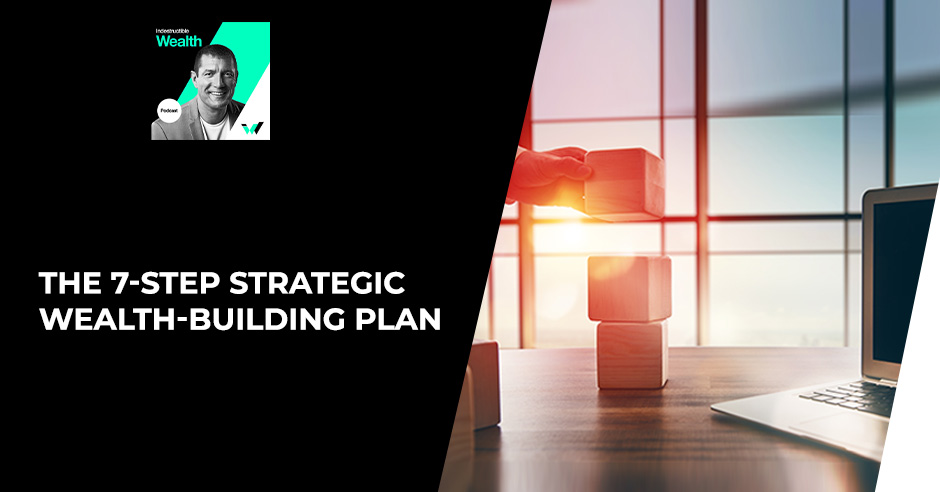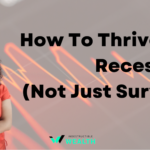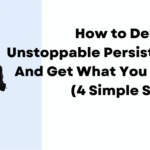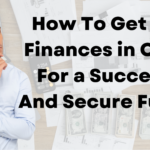
Introducing the seven-step plan for building Indestructible Wealth. In this episode, we introduce and begin to break down the seven steps to building wealth.
About IW: I’m Jack Gibson. I’m your wealth strategist and I’m here to help you make some money. The Indestructible Wealth Podcast is for young entrepreneurs who want to make, keep and grow wealth to enjoy now, and for years to come.
—
Table of Contents
Listen to the podcast here
The 7-Step Strategic Wealth-Building Plan
In our inaugural episode, we laid the groundwork for how the wealthy think and act when it comes to investing and building wealth. On this show, we’re going to dive into a specific strategy that will give you a broader view of how you can formulate your own plan to build indestructible wealth. What I’ve personally found over the years is an overwhelming amount of advice on tactics, what stocks, properties or markets to buy in. “You should be buying gold because the government is printing money.” Buy cryptocurrency and get in early. Each idea could be good or bad depending on how it fits into an overall strategic plan. I’ve seen very little advice over the years on how to formulate an actual plan.

Building Wealth Strategies: Each idea could be good or very bad, depending on how it fits into an overall strategic plan.
I’m going to give you each of the seven steps that will guide you on your journey. Over the next several episodes, we’ll take a deeper dive into each of these steps and help you get very clear on how this plan will work. After each step is fully explained, from there, we’ll be bringing on guests and dive into specific investments that all tie back into the overall seven-step strategic plan. You don’t want to miss this episode as it’s key to building indestructible wealth.
—
In this episode, we’re going to dive into my seven-step strategic process or plan for 2021 and beyond. We talked a lot about leading some groundwork for how the wealthy think and what the entrepreneurial dilemma is. If you didn’t read episode one, you’ve got to go back because that’s the foundation of the entire platform. We’re going to dive into an overview of all seven steps. This is to give you the beginnings of thinking about what your strategic plan would look like.
You don’t have to agree with everything that I say, nor do you need to do everything I say. However, there’s a lot of wisdom that’s packed behind these seven steps. This is what’s worked for me to create over ten different streams of income. I’m super convinced that this is going to going to make a big difference in your life. Let’s go. We talked about how back in college I saved up $50,000, invested in risky tech stocks, lost half of it, and had to sell them off to get some cash and to live.
Years ago, I was still in the stock market and I was doing options. Options is a way to essentially rent out your stock while you are owning it. It’s a way to create additional streams of cashflow off your stock. There are different ways to play options, and you don’t even need to own a stock to participate in Options, which is it’s an even riskier way to play. However, there are a lot of people that know how to do that. They have a system and a process that has worked for them over time. I was in a stock called InterOil. It was a natural gas company when oil prices crashed or dropped big time right around that mark, even though I wasn’t in an oil stock because it was called InterOil, my stock dropped in half. It wiped out a lot of gains.
I had all this income that I had generated from writing these options off this stock, but because the stock was super volatile and much of my eggs were in that one basket, that one stock, and when it dropped, that hurt. I had to take a good hard look inside myself and ask some serious questions at that time. What I discovered was, one, it’s very hard to accept a simple truth. I was a successful entrepreneur, but I was a pretty terrible investor. I was pretty financially illiterate. I knew how to make money in business and was confident I could create value in whatever I set my mind to do. I knew how to keep it a bit, but I certainly didn’t know how to grow it effectively.
I had no financial plan, and I did not understand how the money game works. One of my favorite business philosophers is Jim Rohn. He described the day that he lied to a girl scout. A girl scout comes knocking on his door, puts a big pitch on him, and he wants to buy, but the problem is he has no money. He lies to her and said, “I already bought a bunch of cookies from these other girl scouts.” She says, “No problem.” She goes on her way. He closed the door and he’s like, “Where have I gone in life? I don’t have any money to buy girl scout cookies and I’m lying to a girl scout. I hit the rock bottom.”
That was the day for him. He said, “I resolved that day to become better, to learn and create new skills.” The day that my stocks dropped in InterOil was the day when I made a decision. I said, “I’m not going to live the rest of my life like this anymore, writing the ups and downs of not knowing how to play the money game. I’m going to learn the money game.” That day, I resolved to become what Robert Kiyosaki described to me when I read the book a couple of decades ago, Rich Dad Poor Dad, one of the greatest financial books of all time. If you haven’t read it, you’ve got to read it.
He said, “You want to become what’s called a sophisticated investor.” He describes a sophisticated investor as an investor who understands the words and can speak the language of an investor and who can invest their money with a high degree of safety because they know how to buy cashflowing assets at the right prices. I can’t say like, “I’m a sophisticated investor.” I can’t honestly say that, but I do know I’m getting pretty close.
I know that the journey I’ve been on over the past years, however painful it has been, has transformed my knowledge. I do believe that I can invest much more safely with a high degree of success. The plan that I formulated is helping me protect our family’s lifestyle, while at the same time giving us a chance to create some potentially amazing growth in our portfolio and in our wealth.
If I ever had a chance to go back in time or if time travel is ever invented, I would go back and talk to myself when I was 22 years old right before I invested those stocks in the dot-com bubble, I would give myself this advice, what I’m sharing with you. Why do you want to have a strategic plan? Is it to protect you from yourself? I need protection from myself because my emotions swing from month to month. I’m emotional and greedy at various levels like every human being. When you have a plan that dictates what you do, you don’t swing your decisions from month to month, and end up doing something very stupid and costly. If you have a plan and you execute that plan, applying pressure consistently in the marketplace, no one can stop you.
If you have a plan and you execute that plan, applying pressure consistently, no one can stop you. Share on XWhen I looked at different models over the past years, it seems to me that the vast majority of advisors, coaches and gurus are either in 1 or 2 camps. They’re either all about safe steady cashflow or appreciation, which is also called capital gains. Cashflow investing by, in essence, you want an income from rental properties, dividend stocks, bonds, mortgage back notes and there are several others on how you can do that. Capital gains investing is buying assets that you want growth and value from like high-growth stocks and cryptocurrencies. You could do like a fix and flip speculative housing project. Although I’m predominantly a cashflow investor, I believe that a mixed strategy will be very important over the next decade.
There are going to be many incredible technological breakthroughs and advances in tech that it’s going to going to be look-like a kindergarten class. It’s going to be crazy what we’re going to see. We want to be positioning ourselves in front of some of these technological breakthroughs so that when they do hit the marketplace, we can explode our wealth and get to where we want to be so much faster. There are two problems that people may not even considering about only cashflow investing, taxes and speed of growth.
Cashflow passive income is taxed at ordinary income rates. Whatever tax rate you’re at for your income, that’s what’s your tax set for your passive income. Capital gain is capped out anywhere from 15% to 20% usually depending on your tax bracket. With a new administration, things can change. I don’t know if it’s going to change, if they’re going to mess with that or not, I have no idea, but it’s a big difference. A typical solid cashflow investment doesn’t have a lot of big upside growth potential.
This strategy is going to give you the security that a cashflow strategy offers and the financial independence along with taking some swings for the fences, going for some quick big jumps and wealth that if they work out, you’re totally fine. If they don’t work out, you’re totally fine too. You got to watch the movie Moneyball. This movie is sweet. I love this movie. One of the scenes is you’ve got to see it where he is in the boardroom with scouts. If you don’t ever see this movie, I feel bad for you because it’s relevant to investing.
It’s based on the true story of general manager Billy Bean of the Oakland A’s. He lost his top home run guy, Jason Giambi, and the A’s did not have the budget to replace him. They had the lowest budget in all Major League baseball. He brought in a young analytics guy from Yale who showed him statistically how they could pick up several guys for value, AKA cheap contracts that were good at getting on base. They were not home run superstars. They weren’t hitting the long ball by any stretch, but they could effectively get on base. By implementing this plan, even though he got severe backlash from his scouts, he made a great run with the A’s and maximized the budget constraints he had to deal with. Many other organizations inside of Major League baseball eventually copied his plan.
I equate this with the cashflow strategy. You get on base and form a solid foundation. When the timing is right, the base is loaded, nobody out, you’ve got a good guy up to bad one of your home run hitters, swing for the fences and take some well-calculated swings. By far over the course of your lifetime, your biggest expense is going to be tax. You’re going to pay upwards of or more than 50% of your total income to taxes. That doesn’t mean that you’re in the 50% tax bracket. When you had federal, state, Medicare, unemployment and property sales taxes along with the hidden tax of the government printing huge, large-scale amounts of money unencumbered. It is more than likely as higher than 50%, far bigger than your house car, education and food. We’re going to talk a lot about tax strategies. We want to pay our fair share, but not more than that.
Here are the seven steps, and we’re going to be taking a much deeper dive as we continue on down the show. Make sure you’re following along in all my different channels so that you can get all the goods that I’m going to deliver because we’re going to give you guys concepts and strategies, but we’re also going to give you specific tactics. That’s another problem I found with a lot of the education out there. It’s very conceptual in nature, and there are not enough tactics or it’s very tactic-oriented. Meaning how do you analyze the property? How do you buy properties? How do you buy or pick out stocks without taking the time to set the stage with the strategy and overarching theme of how you want to move forward?
Step One: Increase Your Earning Power By Improving Your Work Ethic And Skills
Step one, focus on increasing your ability to earn more money by improving your work ethic and still skills. You got to make more money. You’re not building wealth by cutting back. This is productionist thinking versus reductionist thinking. Productionist thinking always asking the question, “How can I create more value? How can I be of service to others in exchange for higher pay?”
You got to make more money. You're not building wealth by cutting back. Share on XIf you’re an employee and you’re kept at a certain wage, or maybe you’re not kept, but your income will only rise with inflation like teachers and the vast majority of W-2 earners then you almost certainly will need to create a side hustle. Your primary investment at this stage, stage one is in yourself. Get the courses, coaching, read the books, programs, seminars, or anything you can get your hands on that you can improve your overall value. Be veracious in your quest to get better at what you do, with your disciplines and your work habits. You’ve got to make more money.
This starts the whole process of accelerating your wealth-building journey. Start thinking how you can create that side hustle that you’ve been thinking about doing, but for whatever reason, you’ve procrastinated and haven’t done it. Let’s go. There’s much cash out there. The government printed $2 trillion and $3 trillion. Trillions of dollars in cash have been injected into our economy. Go get yourself a piece of that, “Show me the money. I want it, but I want to earn it by providing value.”
Step Two: Save Over 60% Of Your Income By Choosing To Live Well Below Your Means
Step two, to choose to live well below your means you can save over 60% of your income. I know what you’re saying, “60%, are you fucking off your rocker?” I get it. That’s a lot. I know you’re not going to do that. A lot of you probably can’t even say 10%, but you’re not going to create wealth in any sort of capacity by saving 10%, and making 10% off your 10%. That’s called slow. You’re going to have to work your way up to 60% by increasing your income from step one, but at the same time not increasing your spending in lifestyle. Who are you trying to prove? What are you trying to prove? Who are you trying to prove it to?
You want to buy more stuff that you can’t afford or you want to max out your income every month and you haven’t earned it. This is where most Americans mess up their plan. They get a raise or increase their business growth and instantly they think they deserve to buy a better car, house or vacation. I’m not saying you need to live on ramen noodles and not have any fun. I want to enjoy life now. I don’t want to wait until I’m retired. However, you have to be disciplined to live like no one else you can live like no one else. It’s nice being financially free. I don’t have to work another day for the rest of my life because I did steps 1 and 2. This is the foundation. This isn’t the fun part. We’re going to get to the fund in steps 4, 5, and 6. This is building your house on rock and not sand.
Step Three: Attack And Pay Off Any Debts Higher Than 5% Interest
Step three, attack and pay off any debts higher than 5% interest, especially any and all consumer debts. This is where I deviate from traditional financial gurus. I respect Dave Ramsey. He has done more good for humanity than probably ever. I will hope to achieve this in my lifetime and on a financial level. He says, “All that needs to be paid off. Attack all of your debt.” A simple man says, “This doesn’t make sense to me.”
I’m not a debt coach star. I’m a wealth-building coach. If you want to get out of debt, go talk to go follow him and read his books. He’s brilliant, he’s awesome. He gives straight-in-your-face advice that you need. If you don’t believe that you can confidently earn more than 5% on your money, then you should probably pay off all your debt and play it safe. However, there’s an opportunity cost to paying off low-interest debt. Meaning if I put my cash into paying off my 2% auto loan for example, then that money’s not available to be per work-to-work earning 10%. I know I can earn 10% all day long. The net given up is 8%. If that’s $100,000, then that’s $8,000. I will not earn for that year on that money. That’s opportunity cost. We’re going to dive to the concept of o opportunity cost quite a bit on this show over the course of time.
Step Four: Invest In Well-Researched, Higher-Risk Stocks Using Position Size Bets
Step four, allocate a portion of your investments into well-researched higher risk and therefore huge potential returns using what’s called position size bets. This all depends on age two. If you’re under age 30, you could go up to 20%, you can get riskier. You can get more speculative because you can recover quicker. You got a lot more time to recover from any of those potential losses on your speculative bets. Probably no more than 5% or maybe 10% if you’re over 30. You don’t have quite as much time to recover. If we want to create wealth before retirement age, we can design and live an extraordinary life. We’re going to have a tough road earning, even hiring individuals than paying taxes or spending our way there.
We need to constantly be taking small stabs at gigantic returns while being careful to not get kicked out of the game. With the amount of new disruptive technology being introduced, the potential for huge up upside returns will only exponentially grow. What do I mean by position sizing our bets? This means you’re spreading your funds equally across several bets. We only need to catch a small number to achieve incredible returns. For example, out of 10 bets, 9 go to 0. I place my wager on ten. Equal size bets, 9 go to 0, but one of them goes up 5000%. Then that 1 will more than offset than 9 losers. This is how venture capitalists think and play the game and they are some of the wealthiest people on the planet.

Building Wealth Strategies: With the amount of new disruptive technology being introduced over this next decade, the potential for huge upside returns will only exponentially grow.
Step Five: Put 80-95% Of Your Investments Into Conservative Income-Producing Assets
Step five, put the majority of your investments, 80% to 95%, into conservative income-producing assets. The true definition of financial freedom is when the income from your assets can cover your monthly living expenses. It’s a very simple way to think about financial freedom. When this happens, you’re free because then you don’t have to work for money. Money will flow in every month whether you’re working or not so you can do what you want when you want. This kind of cashflow will only come from safe, stable, boring, and methodical investments that pay interest, rents, and dividends. Things like whole life, cash value and life insurance, “I’ve got my statement in the mail. Thirty-five thousand in dividends came in from my whole life insurance policy. It’s incredible. That’s my safe, stable, boring investment.”
Rental properties, “I’ve got rents coming in every single month from 20 to 25 different properties.” Blue chip stocks with dividends that kick out are solid, stable companies and proven. Mortgage-backed notes is where I would own and note like the bank on a property. For example, an investor is going to be paying me instead of paying the bank, 7%, 8% or 9% on some of those. You’ve got one that’s bigger than that, bonds, private money loans. These are not sexy and not get you rich quickly, but they are fundamental and predictable and dependable.
These multiple streams of income will give you peace of mind and independence, and it will be the formation of almost indestructible multi-generational wealth. How do you find these types of investments? Where do you buy them? Who can you trust? We’re going to be constantly looking at these together. I’m going to have lots of people on my show that I vetted, trust and invested with. I’m going to introduce you to these people and you’re going to be able to invest with them if you choose to. You got to do your own due diligence and research but I’m going to share with you potentially how to avoid mistakes and help position yourself to maximize your returns while minimizing risk.
You can now take that monthly cashflow and place a higher percentage of it into higher risk and reward bets because if they don’t work out, your lifestyle isn’t affected. Your investment funds simply get replenished the following year. More importantly, your lifestyle isn’t affected. Never ever risk your current lifestyle for a better one.
Step Six: Invest Back Into Well-Researched Asymmetric Investments
Step six, this is where it gets fun. You’re going to take a portion of your safe income that you have coming in from your rents, interest payments all of that stuff and dividends, and you’re going to invest that back into well research what’s called asymmetric investments. The way to think of this is it has way more upside than it does downside. This is where you’re risking $1 to make $100 or $1,000, whereas symmetric is risking $100 to make $1 to $10.
How do we find these types of investments? I’m going to share a lot of them with you on my platform. There are very smart guys out there that spend their entire lives analyzing and finding investments that have huge upsides who will charge nominal to their subscribers for their pick. I join a lot of subscription newsletters. They have proven track records, even years of massively beating the stock market returns. Will they be right? I don’t know. Maybe or maybe not, but if they don’t work out, the beauty of this strategy is my investment dollars will be replenished within a year, and you’re still in the game.
As I’m talking here, I’m up well over 100% on an asymmetric play in the cryptocurrency space that was recommended to me by one of the gurus out there. Annualized, that’s a big ROI. If it doesn’t work out, the income from my conserved dividends, rentals and notes would replenish the funds and I could take another stab in short order.
Step Seven: Repeat Until You’re Wealthy, Keep Your Ego In Check, And Enjoy The Journey!
Step seven, this is closing out. Repeat until you’re wealthy and always remember to give generously, keep your ego in check, and enjoy the journey. You’re going to follow steps 1 through 6 over and over. To be honest, if you’re starting out, some of you will probably be on steps 1 and 2 for quite a while. It could be that we want to rush the process and get wealthy. Wealth doesn’t come quickly. Wealth is a slow process. It doesn’t have to be 40 years slow though. It could be a 5 to 10 years type of deal if you do things right.
You don’t have to wait for the rest of your life. You are going to have to make some sacrifices up front, no doubt. I’m not telling you that you’re not getting rich overnight. There’s no way. Most people who get rich overnight don’t have the capacity to be able to handle it. They figure out a way to blow it and get rid of it or self-sabotage because your money is not your money anyways. You’re simply a temporary custodian. We know this because we know you will at some point lose everything you have and it will then be dispersed to others.
We know that’s going to happen. That day will come. We don’t know when that day will come, but we know it’s coming. In other words, it’s God’s money. Personally, I choose to play first in my finances and live a life of philanthropy. I’m not waiting to give until I’ve arrived. If I wait, then I’ll be waiting a long time. Once I hit $1 million, I’m going to give $100,000. That’s not how it works. You’ve got to start building that muscle when the amounts are small. Start off with 1% if it’s tough for you to give. Start off with 2% or 5%, pick a number, and then put that on autopilot to wherever you feel called to give that money.
Personally, I have an autopilot set up that on the same date every single month. An automatic payment goes out to my church every single month without fail. Why did I set that up? I knew that I needed to protect myself from myself because one month I might be like, “I don’t want to donate. I want to buy something. I want to keep this for myself.” Autopilot is the best way to make sure that you follow through on what you say you want to do and how you want to live your life. If I wait to give, I’ll be waiting a long time because as the saying goes, “How much is enough?” A little bit more.
That’s a wrap for this episode. Before we part ways, I want to help you take advantage of two incredible tax-saving strategies that could help you save a lot of money. All you have to do is leave me a five-star review if I’ve earned it, and comment on iTunes, Stitcher, or wherever you tune in. After you’ve done that simple step, email me a screenshot at [email protected], and I’ll send you everything you need to save money on your taxes for years to come.
If you’d like to dive deeper into your own wealth-building strategy, check us out at MyIndestructibleWealth.com, and follow along on social media. Also, please share this show with anyone who’s looking for guidance on their own wealth-building journey. Until next time, remember, our mission here is to help you make, keep, and grow the wealth you can enjoy now and for years to come.
Important Links
- Episode One – Past Episode
- Rich Dad Poor Dad
- iTunes – Indestructible Wealth With Jack Gibson
- Stitcher – Indestructible Wealth With Jack Gibson
- [email protected]





